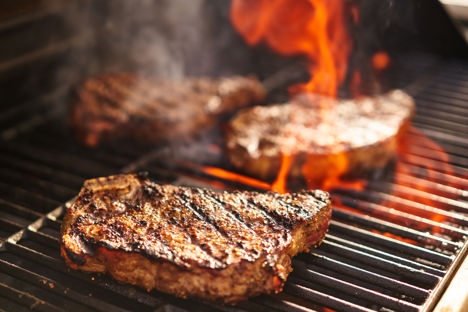
The Maillard reaction explained
Ever wondered exactly why steak tastes so good? It's down to a chemical reaction that turns the charred crust into something incredible. We take a look at the science behind this, and how you can ensure you're getting the most flavour out of your steak every time.
The Maillard reaction explained
Ever wondered exactly why steak tastes so good? It's down to a chemical reaction that turns the charred crust into something incredible. We take a look at the science behind this, and how you can ensure you're getting the most flavour out of your steak every time.
In 1910, chemist Louis Camille Maillard discovered one of the most important chemical processes occurring in food as it’s cooked. He found that, when food reaches a certain temperature – around 140 to 160°C – a reaction occurs between amino acids and sugars. Over time, this process instigates a chain reaction, where more and more reactions (their chemical compounds far too long and numerous to name) subsequently take place. To you and me, this means these processes ultimately create a deeper fidelity of flavour within the food.
Whether you’re toasting bread, frying bacon, roasting meat, searing steak or making chocolate, the Maillard reaction becomes clear when food turns brown – like a good crust on a loaf of bread, or the dark hues in a roasted coffee bean. With a few exceptions, this only happens with the application of ‘dry heat’ however. As Harold McGee writes in his voluminous book On Cooking, ‘If fresh meat never gets hotter than the boiling point of water (100°C), then its flavour is largely determined by the breakdown products of proteins and fats. However, roasted, broiled and fried meats develop a crust that is much more intensely flavoured, because the meat surface dries out and gets hot enough to trigger the Maillard or browning reactions.’
But before it gets a bit too scientific, the question this information arouses is this: How can we harness the power of the Maillard reaction to create a darn good steak?
Pan-frying obviously has its uses as it allows meat to come to a high temperature quickly, encouraging Maillard browning, ergo flavour development. It’s good to note the usefulness fats within the meat and external cooking oils provide here – they both help steak, which typically has an uneven surface, retain a uniform contact with the pan. In this sense, oils and fats act as catalysts, dehydrating the surface of the meat so that it can brown. Meanwhile, the interior of the meat retains its water content, staying juicy and tender.
So what does all this mean for the chef? Making sure your pan is smoking hot before introducing a steak – preferably with a good fat content to get a good surface temperature on the meat – is usually a good way to go, though the intensity of the temperature depends on the cut you’re using. And of course don’t cook for too long, or you’ll go past the desired effects of the Maillard reaction, where food starts to char, and creates an environment for some fairly nasty carcinogens.
The other typical method in cooking steak involves grilling or barbecuing, which takes a little more understanding but can yield more flavour due to the aroma compounds released by burning charcoal or wood. ‘The key,’ writes McGee, ‘is to position the food far enough from the heat source to match the [Maillard] browning rate with the inner conduction rate, or to brown the surface well with intense heat, and then move the food to finish cooking through with a more distant or weaker source. This might be a spot on the grill with fewer coals below, or a moderate oven.’
While a basic knowledge of the Maillard reaction helps in the cooking of almost any savoury food (caramelisation is the equivalent process occurring in sugar-based food, by the way), it’s the sort of science you may find useful to understand if you’re trying to get your head around cooking the perfect steak. After all, appreciating why that pan needs to be this hot, or why you need to cook the meat for that long, could ultimately be what helps bring out a better flavour in your steak.

